

Community Supported Agriculture. Thinking about signing up for a CSA but want to learn more about the idea before you commit?
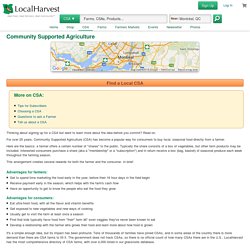
Read on. For over 25 years, Community Supported Agriculture (CSA) has become a popular way for consumers to buy local, seasonal food directly from a farmer. Here are the basics: a farmer offers a certain number of "shares" to the public. Typically the share consists of a box of vegetables, but other farm products may be included. Interested consumers purchase a share (aka a "membership" or a "subscription") and in return receive a box (bag, basket) of seasonal produce each week throughout the farming season. This arrangement creates several rewards for both the farmer and the consumer.
Advantages for farmers: Get to spend time marketing the food early in the year, before their 16 hour days in the field begin Receive payment early in the season, which helps with the farm's cash flow Have an opportunity to get to know the people who eat the food they grow Advantages for consumers: Variations Shared Risk. Home. Waste = Food. Man is the only creature that produces landfills.
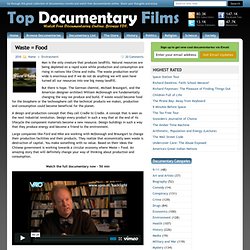
Natural resources are being depleted on a rapid scale while production and consumption are rising in nations like China and India. Graue Energie. Größenordnungen[Bearbeiten] Das Statistische Bundesamt Deutschlands errechnete, dass im Jahr 2003 die durchschnittliche Energieintensität aller Waren ohne Energiegüter 4,5 MJ/EUR betrug.[1] D. h. im gesamtwirtschaftlichen Mittel verursacht jeder Euro, den ein Endverbraucher ausgibt, zirka eine Kilowattstunde (= 3,6 MJ) an „grauer Energie“ (ausgenommen direkter Kauf von Energie).
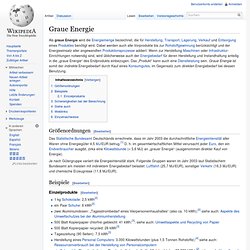
Je nach Gütergruppe variiert die Energieintensität stark. Folgende Gruppen waren im Jahr 2003 laut Statistischem Bundesamt am meisten mit indirektem Energiebedarf belastet: Luftfahrt (25,7 MJ/EUR), sonstiger Verkehr (16,3 MJ/EUR) und chemische Erzeugnisse (11,8 MJ/EUR). Virtuelles Wasser. Als virtuelles Wasser bzw. latentes Wasser wird jenes Wasser bezeichnet, das zur Erzeugung eines Produkts aufgewendet wird.
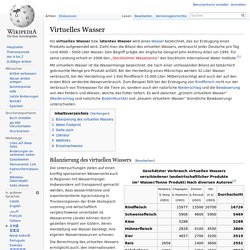
Zieht man die Bilanz des virtuellen Wassers, verbraucht jeder Deutsche pro Tag rund 4000 – 5000 Liter Wasser. Den Begriff prägte der englische Geograf John Anthony Allan um 1995. Für seine Leistung erhielt er 2008 den „Stockholmer Wasserpreis“ des Stockholm International Water Institute.[1] 350.org. Startseite. Untitled. IG Metall - Kurswechsel. Dutch Research Institute for Transitions. Grüne Karriere. Environmental Justice. Marie-Monique Robin.
Global Energy Efficiency Opportunities - Carnegie Moscow Center - Carnegie Endowment for International Peace. While energy efficiency measures will not end the serious global climate change challenge, adopting such measures would buy time to further the development of alternative low-carbon energy resources.
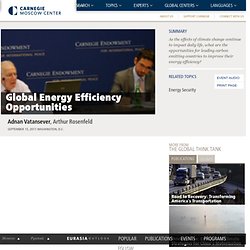
White roofs can cool buildings, cities, and even the planet. Implemented worldwide, cooler cities could bring the world 5 percent closer to avoiding future climate disaster. 2011 Global Energy Prize recipient and Distinguished Scientist Emeritus at Lawrence Berkeley National Laboratory, Rosenfeld, spoke at Carnegie about the impact of the energy efficiency concepts around the world and the potential of white roofs to slow global warming. Global energy. ЭКОЗАЩИТА! Earth First! Journal. Demo gegen Lebensmittelverschwendung - Abfall schmeckt gut - München. Anzeige.
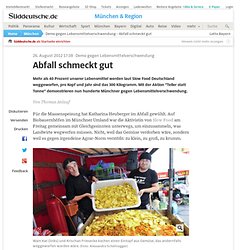
SAMUI'S GREEN REVOLUTION. It all started three years ago when a group of Samui residents, both Thai and foreign, were stressing over the damage being done to the island's natural environment.

"Why don't they do something about the over-development ... deforestation ... lack of infrastructure," had become the refrain of concerned residents who watched from the sidelines for years as rapid development took its toll on the island's once pristine natural environment. Ökoeffizienz. Cradle-to-cradle design. Cradle to Cradle design (also referred to as Cradle to Cradle, C2C, cradle 2 cradle, or regenerative design) is a biomimetic approach to the design of products and systems.
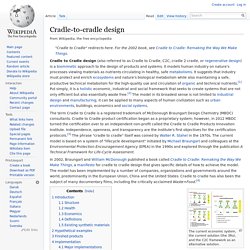
It models human industry on nature's processes viewing materials as nutrients circulating in healthy, safe metabolisms. It suggests that industry must protect and enrich ecosystems and nature's biological metabolism while also maintaining a safe, productive technical metabolism for the high-quality use and circulation of organic and technical nutrients.[1] Put simply, it is a holistic economic, industrial and social framework that seeks to create systems that are not only efficient but also essentially waste free.[2] The model in its broadest sense is not limited to industrial design and manufacturing; it can be applied to many aspects of human civilization such as urban environments, buildings, economics and social systems.
Introduction[edit] Biological and Technical Cycles Biological and technical cycle. Suffizienz (Ökologie) „Einer naturverträglichen Gesellschaft kann man in der Tat nur auf zwei Beinen näherkommen: durch eine intelligente Rationalisierung der Mittel wie durch eine kluge Beschränkung der Ziele.
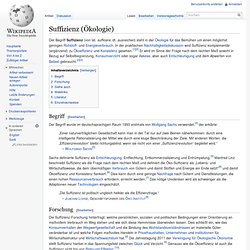
Mit anderen Worten: die „Effizienzrevolution“ bleibt richtungsblind, wenn sie nicht von einer „Suffizienzrevolution“ begleitet wird.“ „Die Suffizienz ist politisch ungleich heikler als die Effizienzfrage. Energy conservation. Ökoeffektivität. Das Cradle to Cradle-Konzept (engl., dt. sinngemäß Von der Wiege zur Wiege) beschreibt eine Form zyklischer Ressourcennutzung, in dem Produktionsweisen am Erhalt geschöpfter Werte ausgerichtet sind.

Analog dem Nährstoffzyklus der Natur, in dem "Abfälle" eines Organismus von einem anderen genutzt werden, sollen in der Produktion Materialströme so geplant werden, dass Abfälle sowie eine ineffiziente Nutzung von Energie vermieden werden. Das Cradle to Cradle-Konzept wurde 2002 von Michael Braungart und William McDonough entwickelt[1]. Das Konzept basiert auf einem Begriff, der in der 1970ern durch den Schweizer Architekten Walter R. Stahel eingeführt wurde. Entstehung und Entwicklung[Bearbeiten] Seit der industriellen Revolution vor 200 Jahren tragen Produktionsverbesserungen kontinuierlich dazu bei, dass der Lebensstandard steigt.
Story of Change. Over the past several decades, many environmental and social change efforts have come to reflect the centrality of shopping in our culture, suggesting change can be made—or is even best made—through alterations in our individual consumption patterns. The Story of Stuff. The Story of Change. Shale gas 'not the optimum path to carbonfree environment': Fatih Birol. An energy strategy without fossil fuels would be preferable to the regulated gas pathway outlined in the International Energy Agency (IEA)’s new report, the paper’s own author told EurActiv in an exclusive interview yesterday (30 May). An increase in unconventional gas production would be “a good move if it replaces coal,” Fatih Birol, the IEA’s chief economist said at the launch of ‘Golden rules for the Golden Age of Gas’ in Brussels, “but it is definitely not the optimum path.”
“The optimum path would be to see more renewables, more efficiency and more low carbon technologies,” he added. Shale gas has the potential to bridge the transition to a decarbonised economy, if a series of social, regulatory and environmental rules are followed, the IEA’s report says. Renewable energy. Energy politics (Gas, Oil, Pipelines)
Innovations&Concepts. Related Topics. Blogs. Journal entries. News Articles. Official Websites. CO2 emissions, birth & death rates by country, simulated real-ti. In Deep Water: Can we afford to spill any oil? Info Collection.